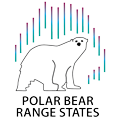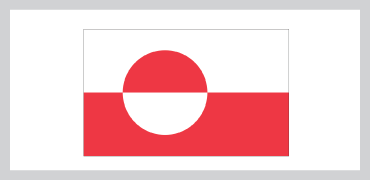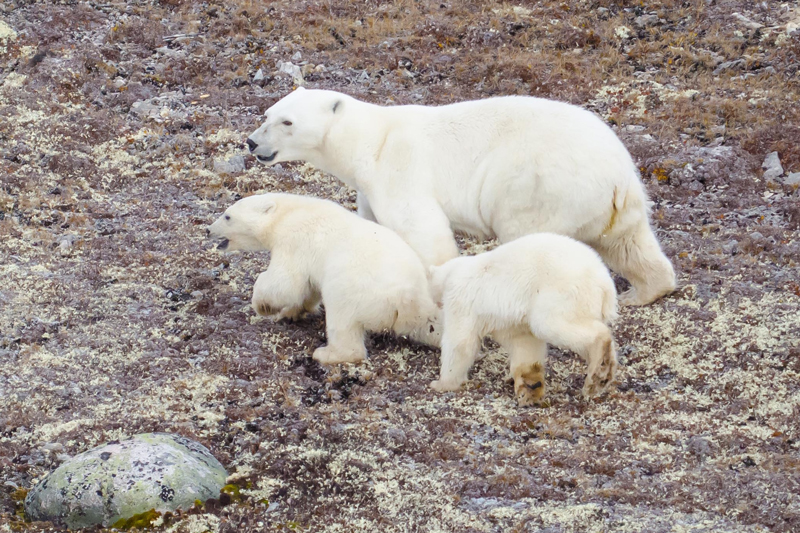 Photo credit: Peter Hale, Department of Environment, Government of Nunavut
Photo credit: Peter Hale, Department of Environment, Government of Nunavut
Canada is home to 13 polar bear subpopulations and approximately two-thirds of the global polar bear population. The 13 subpopulations are distributed across four provinces and three territories. Three subpopulations are shared with Greenland and one is shared with the United States. Canada’s polar bear management system is grounded on both science and Indigenous and Traditional Knowledge (ITK). A critical piece of information for effective management is the number of polar bears that comprise a subpopulation by undertaking periodic population inventories (including physical mark-recapture, genetic mark-recapture, and aerial surveys). ITK provides invaluable information from those who have coexisted with polar bears for millennia on many aspects of polar bear biology, conservation, and management (e.g., migration patterns, denning habits, and observed changes in the abundance, movements, and habits of polar bears).
Legislation
In 2011, the polar bear was listed as a Species of Special Concern under the Federal Species at Risk Act (SARA), which manages species of Special Concern to prevent them from becoming endangered or threatened because of a combination of biological criteria and identified threats. The polar bear is also listed as being at risk under provincial/territorial legislation in Manitoba, Ontario, Quebec, Newfoundland and Labrador, and the Northwest Territories. Various management plans or recovery strategies are either in place or under development in these jurisdictions.
A Special Concern listing warrants the development of a National Polar Bear Management Plan, which will set goals and objectives for maintaining sustainable population levels of the species. The National Polar Bear Management Plan will be comprised of a federal addition (Part 1), and a compendium of jurisdictional management plans and recovery strategies (Parts 2 to 7). Incorporation of the jurisdictional management plans and recovery strategies will reflect the reality of Polar Bear management in Canada and result in appropriate and effective delivery of conservation measures while helping to ensure that Indigenous rights holders will continue to have harvest opportunities. Environment and Climate Change Canada is working in collaboration with co-management partners (for example provincial and territorial governments, Wildlife Management Boards/Advisory Council, Indigenous organizations, etc.) to develop the National Polar Bear Management Plan. More information is available here: Polar Bear (Ursus maritimus): management plan progress report, March 2023 - Canada.ca
Habitat Protection
Within polar bear range, Canada has five national wildlife areas, six marine protected areas, 12 national parks, 23 migratory bird sanctuaries and 58 provincial and territorial parks (as of 2023).
Management System
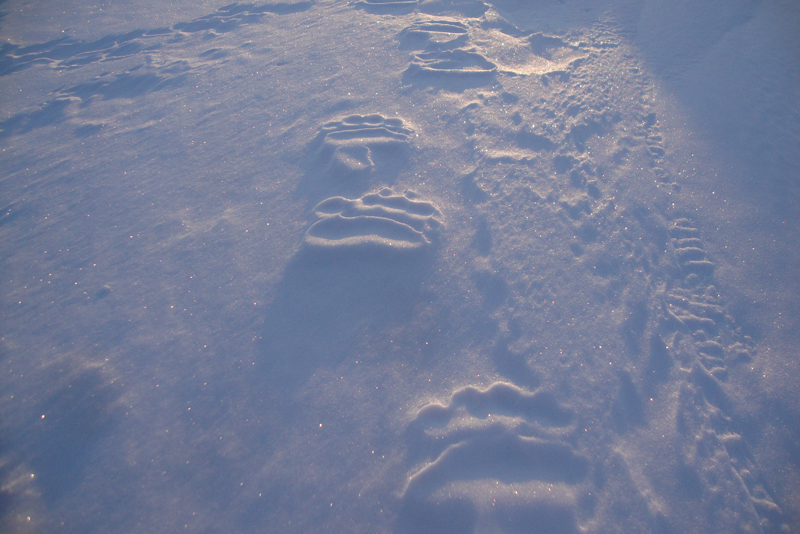 Photo credit: Markus Dyck, Government of Nunavut
Photo credit: Markus Dyck, Government of Nunavut
Polar bear management is a shared responsibility among the federal, provincial and territorial governments, Wildlife Management Boards/Advisory Councils, and Land Claim Organizations that represent Indigenous rights holders. Wildlife Management Boards/Advisory Councils within polar bear range were established under Land Claims Agreements as institutions of public government to manage and regulate wildlife within their respective area/regions.
With a formal quota system, final decisions on harvest quotas are made by the relevant Wildlife Management Boards/Advisory Councils and provided to the responsible Minister who may accept, reject or vary the decision and provide reasons for rejecting or varying the decision. The Minister shall then proceed forthwith to do all things necessary to implement the final decision. The decision-making process considers advice based on best available science (including periodic population inventories, harvest reporting, emerging threats and other relevant research, etc.) and Indigenous and Traditional Knowledge (including observations of problem bears, migration patterns, denning habits, etc.) provided by a multitude of stakeholders, partners, and interested parties, including governments, technical experts (scientists and Indigenous peoples) and non-government organizations.
Formal management systems receive broad and overarching support from the Polar Bear Administrative Committee (PBAC), which receives technical advice and support from the Polar Bear Technical Committee (PBTC). The PBAC and PBTC are comprised of representatives from federal, provincial and territorial governments, Wildlife Management Boards/Advisory Councils, and Land Claims Organizations The committees work to provide annual assessments on the status of each of Canada’s 13 polar bear subpopulations and provide advice on polar bear conservation and management actions.
Harvest and trade
Indigenous peoples in the Arctic have been harvesting polar bears for thousands of years and this subsistence harvest continues today. In Canada, the right for Indigenous peoples within polar bear range to harvest polar bears is defined under their respective Crown-Indigenous Land Claims Agreements located in their settlement areas. Indigenous subsistence harvest produces economic benefits for Arctic communities, and polar bear hunting remains an important part of the traditional culture found in northern Indigenous communities. Harvest activities are inextricably linked to culture, wellbeing, and spirituality. Furthermore, in a region where the cost of living is extremely high and economic prospects are scarce, polar bear hunting is a source of nutritious food and provides an opportunity to generate income. Canada permits a regulated and sustainable harvest of polar bears for subsistence purposes, including profits gained from the sale and international trade of polar bear products. A proportion of Canada’s polar bear population is traded annually, providing a culturally significant way in which northern communities can sustain themselves. In recent years (2019-2021) the number of bears exported from Canada amounted to less than 10% of the animals harvested nationally.
Each subpopulation of polar bears in Canada has a harvest quota within their respective jurisdiction in consideration of conservation principles and Indigenous subsistence needs. Canada’s management system is complex, since several polar bear subpopulations fall within more than one jurisdiction and quotas must be divided among multiple communities. All human-cause mortalities (including defense of life or property, subsistence, Inuit-guided hunts (sport hunts), accidental takes and illegally kills) are deducted from the existing quotas in a given region for the current harvest year.. Inuit-guided hunts occur in Nunavut and the Northwest Territories where Inuit hunters are allowed to transfer their exclusive rights under their Land Claims Agreements to another hunter. Sport hunts constitute a small proportion (< 10% in recent years) of the total number of harvested bears, require an Inuit guide and must be conducted using traditional methods (sled and dog team) and with a locally designated quota tag. All aspects of a polar bear hunt are held in very high regard by Indigenous peoples. Those parts of the bear not used by the harvesters and their families or sports hunters are distributed among other members of the community or are entered into trade. When tags for harvested bears are obtained from Conservation Officers, samples are submitted to the responsible government allowing for the sex, age, and genetic information of the animal to be recorded and to assist with monitoring and research.
National Polar Bear Conservation Strategy
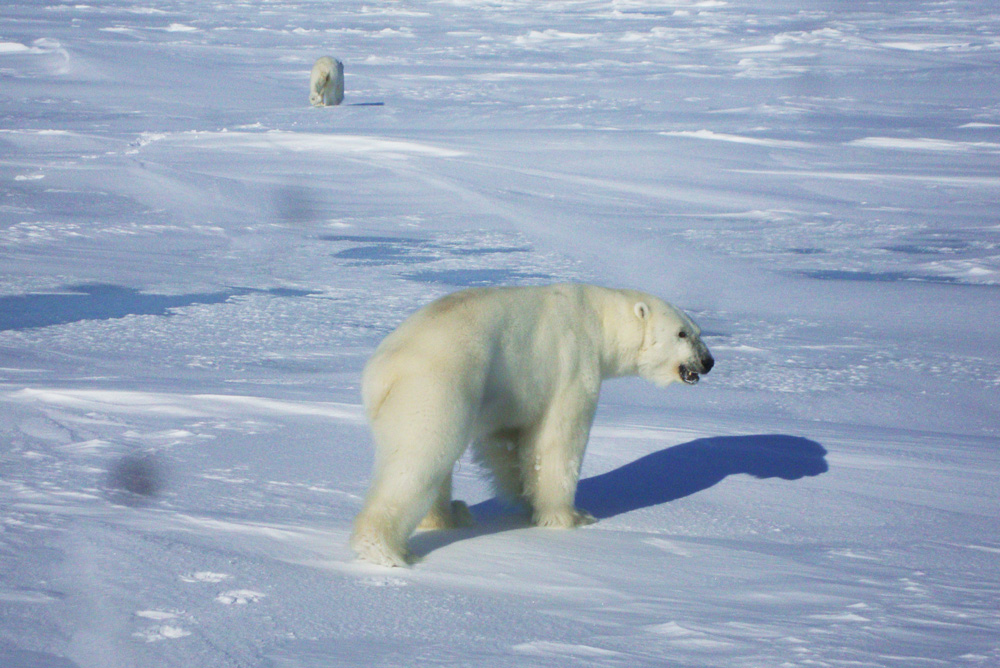 Photo credit: Markus Dyck, Government of NunavutThe National Polar Bear Conservation Strategy, completed in August 2011, was developed by the PBAC. The goal of the Strategy is to increase the level of coordination and collaboration among all Canadian jurisdictions for the conservation and management of polar bears. By increasing collaboration, the Strategy will provide the framework to accomplish the following objectives:
Photo credit: Markus Dyck, Government of NunavutThe National Polar Bear Conservation Strategy, completed in August 2011, was developed by the PBAC. The goal of the Strategy is to increase the level of coordination and collaboration among all Canadian jurisdictions for the conservation and management of polar bears. By increasing collaboration, the Strategy will provide the framework to accomplish the following objectives:
- promote actions that contribute to the long-term maintenance of polar bear subpopulations, both within Canada and shared with other countries;
- minimize threats to polar bears and their habitat that result from human activities; and
- ensure that best practice standards for polar bear management and research are adopted and respected, including the continued development of non-invasive methodologies and the incorporation of ITK.
The Strategy defines the roles and responsibilities of each management partner, recognizes the key threats that face polar bears in Canada, and includes an inventory schedule for subpopulation monitoring. The Strategy acknowledges that climate change is an overarching driver of several threats. Other key threats include contaminants, mineral and energy resource development activities, marine shipping, unsustainable harvest levels and human-bear conflicts.
For more information
For information pertaining to the Convention on International Trade in Endangered Species (CITES), and actions being undertaken by the Government of Canada to conserve and manage polar bears, please visit the Government of Canada website. For general information related to polar bear biology, habitat, threats and protection in Canada, please visit Canada's Species at Risk Public Registry.
